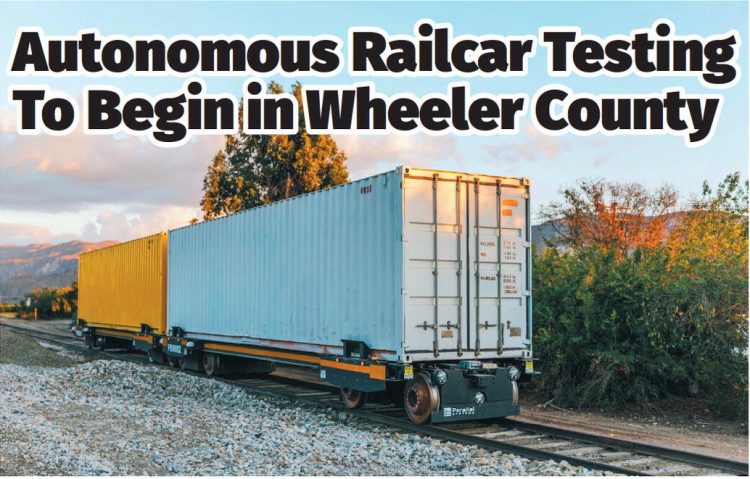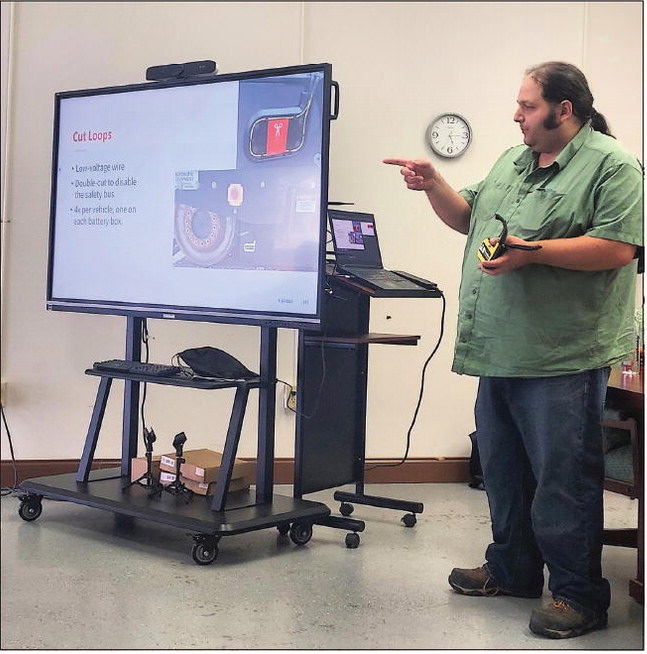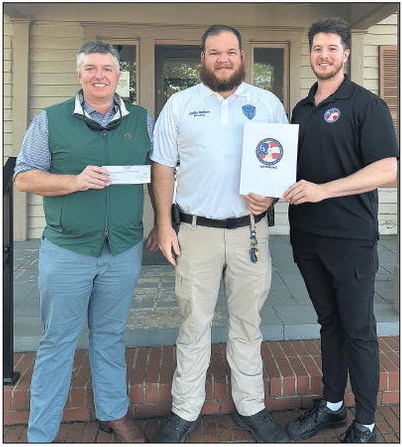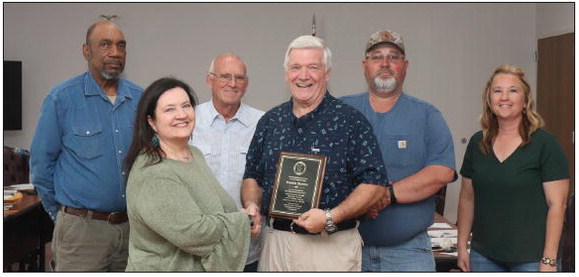Autonomous Railcar Testing To Begin in Wheeler County


If testing goes well, South Georgia could soon be seeing autonomous battery-electric railcars on its railways.
Representatives of Parallel Systems, the California-based company developing batteryelectric railcars that operate autonomously, met last week with public safety officials in Alamo where they outlined plans for the first phase of testing that will begin within the next month in Wheeler County. A specific date for testing was not announced.
In January, the Federal Railroad Administration (FRA) approved a request from Parallel, continued from page
Georgia Central, and Heart of Georgia Railroad to test the self-propelled intermodal flatcars.
The seven-phase testing program on the two Genesee & Wyoming short lines will begin with testing on two miles of track near Stuckey. The test will be conducted on a Heart of Georgia line that will be disconnected from the rest of the railroad. The test section is west of Stuckey Church Road and east of Forestry Road and has no crossings or switches.
Ethan Weil, program manager for Parallel, said the test will involve a single car that will not be carrying any cargo, and which will be monitored by crews on site and from a remote location based in Pitts in Wilcox County. The cars have multiple, on-board sensors which activate in emergencies, and which can bring the car to a stop, but during testing a support team with emergency stop capabilities will be following the test car.
Safety is the first consideration, Weil said during the Alamo training session. When asked by local officials about how the company will ensure public safety during the test, Weil explained that the autonomous system relies on cameras and sensors, as well as software in computers on board the car and at a data center. Electronic brakes can bring cars to a stop in 10 times less distance than conventional equipment with air brakes.
James Unger, Manager of Field Operations for Parallel, who will be based at the data center in Pitts, explained that each car is outfitted with horns and lights to alert motorists that the railcar is approaching a crossing. The cars also have lights and reflectors which make them more visible at night. “Cameras are mounted on the front and rear of the car, as well as in the middle, providing a 360-degree view,” Unger said of the car’s safety mechanisms that are continually monitored at the data center.
The cars will look much different than conventional trains as they travel along the tracks. Don’t look for an engineer; these cars won’t be carrying a crew. Since batteries in each truck power the car’s traction motors, they do not need an engine to propel them along the tracks. The cars — which can run alone or together as an autonomous platoon of up to 50 cars — can each carry a single container. They can operate at up to 25 mph and tackle grades as steep as 3%. Parallel’s prototype flat car can carry one intermodal container 500 miles on a single battery charge.
The Seven Phases of Testing The complexity of the operations will increase with each phase of the test program, and the FRA must deem each phase successful before the companies can move on to the next phase, Parallel said in a news release.
The tests aim to evaluate the three primary components of the Parallel system: the autonomous vehicles themselves, the user terminals that allow people to control the equipment, and the computer servers that send data between the vehicles and the user terminals.
The test program will be conducted on portions of the Heart of Georgia line from Milepost 663, just east of Cordele, to the connection with Georgia Central at Milepost 577.8 in Vidalia, and then on Georgia Central from Milepost 577.8 to Milepost 503 near Pooler. The first phase will involve only the two-mile section of track in Wheeler County that will be severed at both ends.
Phase two will be expanded to a 30-mile section of the Heart of Georgia. Testing will be performed under track warrants with no other rail operations present and all public grade crossings protected by flaggers.
Phases three and four will operate over an 84-mile section of track between Vidalia and Cordele on the Heart of Georgia and will include tests under track warrant control as well as in yard limits. The HOGNorfolk Southern diamond at Milepost 610.7 will be protected by derails.
The fifth phase of testing will incorporate updated hardware and will involve the first use of containers on the Parallel cars on a 30-mile section of the Heart of Georgia, between Vidalia and just east of Helena.
Testing ramps up in phases six and seven and will operate over a 160-continued from page
mile section of the Heart of Georgia and Georgia Central.
“Phase Six operations are intended to evaluate the operational effectiveness of the System in field conditions operating intermixed with conventional rail service as governed by the railroad dispatchers and operating rules. Containers containing test weights will be transported on the Vehicle,” the application for testing submitted to the FRA says.
The final phase will evaluate platooning with loaded containers. “A limited number of revenue containers may be moved in Phase Seven, allowing for an assessment of damagein- transit, to compare this unique new technology with direct truck competition. Otherwise, containers will carry test load weights,” the application says. Public Comment, Company Projections The G& W railroads are viewed as ideal test beds due to their proximity to the booming Port of Savannah and their isolated sections of track with no grade crossings. Ultimately, the plan would be to use platoons of autonomous cars to deliver containers to the small intermodal terminal in Cordele, on the HOG railway, which has been dormant since 2017. The goal, as East Coast ports grow, is to take trucks off the road in short-haul markets where the railroad has already proven it can’t currently compete, according to online reports.
The FRA approval grants Parallel, Georgia Central, and Heart of Georgia railroads 22 waivers from car and locomotive regulations that cover everything from cabs and sanders to brake valves and uncoupling levers. The decision includes 23 conditions that Parallel and the railroads must follow during the pilot program.
The FRA received 154 comments during the public comment period. Of those, 32 supported the pilot program while 122 raised concerns. “Although many of the public comments were directly related to safety, many comments, both supporting and opposed to the proposed program, are relevant only if this type of operation were to be approved to operate on the general railroad system, but are not relevant to this specific pilot test program… These comments will certainly be important when/if railroads seek approval for further testing or to operate,” the FRA noted following the comment period.
Parallel announced recently it had raised an additional $38 million in funding, bringing its total to date to about $100 million. “Federal Railroad Administration approval and closing our Series B funding round are two critical milestones for Parallel Systems,” Matt Soule, Parallel founder and CEO, said in a press release. “Together with our strategic partnerships within the rail industry, Parallel Systems is now poised to fully commercialize our battery-electric rail system, starting with the FRA-approved project in Georgia.”
The company said the latest funding will be used to “propel commercialization” of its project with railroad partners in the U.S. and Australia, where it has also demonstrated its product.
Parallel said it already had a backlog of more than 300 of its autonomous railcars with leading railroads and expects to launch commercial operations in 2026. The company said it is scaling production of its Generation 3 equipment and related autonomy software train control systems and has tested its technology’s compatibility with positive train control in collaboration with Union Pacific.
The cars are also undergoing testing in Australia. These product’s “design features are intended to help railroads better compete against trucks in the shorthaul movement of intermodal containers rather than to replace conventional railroad rolling stock,” according to the application for testing.

NATIONAL CRIME VICTIMS WEEK – In honor of National Crime Victims Week being observed on April 6-12, The Refuge Domestic Violence Shelter and Sexual Assault Center set up a display at Southeastern Technical College in Vidalia, which detailed the clothing that anonymous victims were wearing when they were assaulted. Representatives from the organization also hosted a Lunch and Learn event on Tuesday, April 15, where they spoke to Southeastern Technical College students and staff about domestic violence and sexual assault.Photo by Makaylee Randolph

AUTONOMOUS RAILCARS TRAINING – Ethan Weil, Program Manager for Parallel Systems, conducts training for public safety officials last week in Alamo. Wheeler County is the location for the first phase of testing for the self-propelled intermodal flatcars. The test will be conducted within the month on a Heart of Georgia line that will be disconnected from the rest of the railroad.Photo by Deborah Clark





